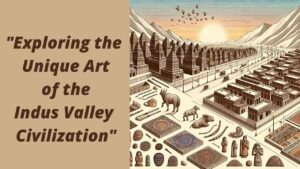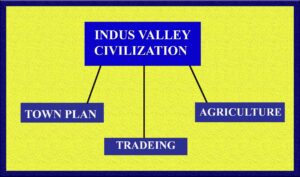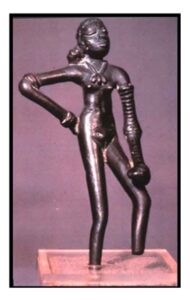ART OF INDUS VALLEY CIVILIZATION

INTRODUCTION
- Indus Valley has given its name to India and its people. The valley of Indus is a huge plain, some 1000 miles long and 500 miles wide .
- Indus valley flourished for approximately from about 2500 BC to 1500BC and then disappeared and was forgotten until the discovery and excavations carried out in Indus valley derived that there were two large cities named Harappa and Mohenjo-Daro.
There are co- exist civilization within IVC:
1)Ancient Egypt civilization
2)Mesopotamia civilization
3)Chinese civilization
4) Indus valley : the biggest among all
LOCATION-
This civilization was mostly concentrated on the bank of the river Indus, so the civilization is called Indus valley civilization. The site also takes its name from modern village called Harappa located near the former course of the Ravi river. Ancient sites of that age which has created typical archaeological material extents from Rupar in Ambala district (Punjab).

TOWN PLAN
It was baised of rid system main roads (north –south) and Alleyes (east-west) under ground Drainage system was also there at that time. Doors of house are open in alleys .AGRICULTURE
Main crops –Wheat ,barley , rice,. Ivc was the first civilization to grow cotton.
DOMESTICATION
Buffolo, Dogs, oxen , sheep,and goats.
TRADES
IMPORT- Tin/ precious stone -from Iran & Afganistan
Gold – Karnataka
copper – Rajasthan , Oman
DIFFERENT ART FORMS OF INDUS VALLEY
The Indus valley people were expert in the art of house building, stone and clay modeling, seal making , bronze casting, making of ornaments of gold and silver and cutting of beads of various semiprecious stones. Mohenjo-Daro and Harappa both were established by advanced urban planning. The art of Indus valley spread extensively both in time and space.
The arts of Indus Valley civilisation, one of the earliest civilisations of the world, emerged during the second half of the third millennium (Bronze Age).
The forms of art found from various sites of civilisation include sculptures, seals, pottery, gold ornaments, terracotta figures, etc.
Their delineation of human and animal figures was highly realistic in nature.
Modelling of figures was done in an extremely careful manner.
Two major sites of Indus Valley civilization, along the river Indus are: North – cities of Harappa; South – Mohenjo-Daro.
PLATE NO-1
TITLE: Dancing girl
MEDIUM: Bronze
PERIOD: MOHAN JODARO (2500 BC to 1500 BC)
DESCRIPTION: This is the greatest achievement of metal workers of MOHAN JODARO . This is the world famous sculpture of young woman perhaps a dancing girl standing nude except for a brief necklace and an arm completely ringed with bangles. Her relaxed body twist so that one hand rest on her right hip while the other hand hold a small bowl against her left leg. Her negro features identify her as one of the dasa as described in the Rig Veda. This dancer is shown resting after the course of dance. So far this 14 cm figure is a single major metal sculpture from MOHAN JODARO site.
COLLECTION: National Museum, New Delhi
TITLE: Mother Goddess
MEDIUM : Terracotta
PERIOD: MOHAN JODARO (2500 to 1500 BC)
DESCRIPTION:
It is one of the best preserved, large sized terracotta , representing Mother Goddess. High crested head gear, necklace around the neck, the series of pendants and broad girdle indicate that the sculptor at Mohanjodaro was perfect in his art and could fashion both realistically and stylistically.
COLLECTION: National museum, New Delhi.
PLATE NO 3
TITLE: Mother Goddess
MEDIUM : Terracotta
PERIOD: MOHAN JODARO (2500 to 1500 BC)
DESCRIPTION:
It is one of the best preserved, large sized terracotta , representing Mother Goddess. High crested head gear, necklace around the neck, the series of pendants and broad girdle indicate that the sculptor at Mohanjodaro was perfect in his art and could fashion both realistically and stylistically.
COLLECTION: National museum, New Delhi.

